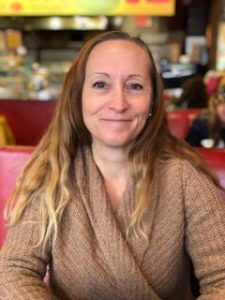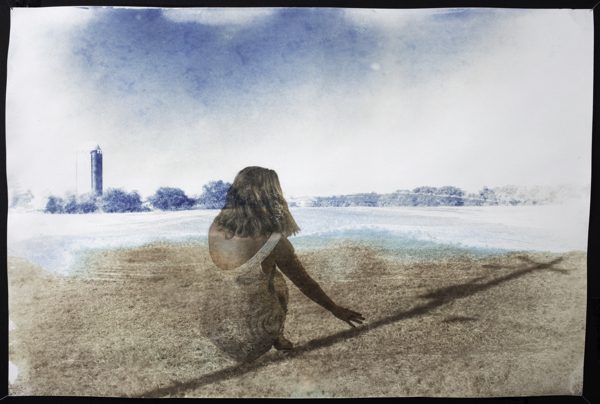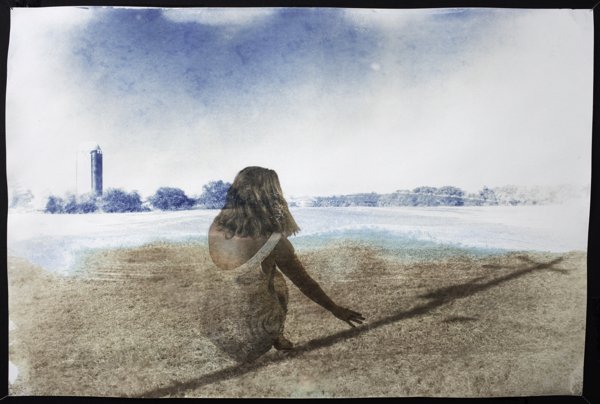“If you can repeat the mistake, then it becomes
a technique that can be used with intention.
Interview by August Smith, WTP Features Writer

Bronwen Hazlett is from many places but nowhere specific. Her dad was a career Navy doctor who took her family from Japan, to the Mid-Atlantic states, and back to Japan again before she went to art school. She graduated from Maryland Institute College of Art in ’92 with her BFA in Photography as well as an MFA in Photography from Academy of the Arts University. She has had many different careers, such as a jewelry designer, publishing company graphic designer, an “in-house” advertising agency photographer, a “stay-at-home” Mom, freelance photographer, graphic and web designer, design firm office manager, an adjunct photography professor, and now a high school Graphic Design Teacher.
Smith: Hi, Ms. Hazlett, thanks for agreeing to answer some of our questions!
The way “place” figures into your work is interesting to me. You lived a transient life growing up, moving between the United States and Japan multiple times; accordingly, your work feels dreamy, like it exists outside conventional place and time. How do you conceive of place? How does it effect your work and approach to photography?
Hazlett: Growing up a Navy Brat gave me a different perspective on the idea of place and what was home. Home for me has always been about where my family lives and not one house. The physical representation of home changes frequently and I’m obsessed with the history of the house I photograph. Because many places have influenced me, my images are more about how a place makes me feel than the importance of where I am.
Smith: Both of your parents were accomplished artists too, exhibiting artwork in Tokyo in the ’70s. Do you ever contrast your art with the artwork of your parents? Are there any interesting similarities and/or differences found there?

Hazlett: I realize now as an adult how much my parents’ art influenced my own. For a very long time I went my own direction with photography and rebelled against using my hand unless it held a camera. In 2010 I gravitated back to my parents influence and began to use the process of collage in my image making. In the past, I avoided collage because who needed it when there was Photoshop. Like for my parents, collage was about using your hand, slowing the image-making process down, and reflecting and therapy. Making a new whole from seemingly disparate parts is like making the best out of what you have and finding new meaning to move forward. It brings back a process of creativity that I feel is lost in today’s photographically effortless and image-drenched world.
Smith: Your work is characterized by its play with color and technique, something you aptly refer to as the “chemistry” of your work. Can you talk a bit about your experimental procedures and processes?
Hazlett: I love color photography and have preferred it to black and white in my early work. I also love experimenting with image making. I want to know how I can do something differently and I don’t like following the traditional image-making rules. I love to “mash-up” and mess things up. There is a plethora of ways to combine technology, new materials, and historical processes. For me, that is where “chemistry” comes into play. It’s all about playing with your materials, process, and images. Even though there are only two colors used in the blue Van Dyke photographic process, their interaction with each other is constantly fascinating me. I’m learning how to use the way cyanotype and Van Dyke brown react to each other chemically to drive the intended emotion in my images.
Smith: How did you start experimenting with these materials, tools, and techniques? Where was the “a-ha!” moment?
Hazlett: In graduate school, I had the opportunity to use both cyanotype and Van Dyke brown together for an assignment. It’s traditionally something you apply and expose separately but I couldn’t see why you couldn’t use them together at the same time for one photographic exposure. I started out keeping the two chemistries apart from each other but I noticed where there was accidental mixing, I was getting really interesting results. As I learned how the two processes behaved with each other through running tests, I started to use the different effects their reactions produced intentionally in the final image making process.
Smith: Your video “The Alchemy of Inspiration” shows you utilizing some of these techniques, and it looks like a labor-intensive, multi-step process. Do you think process and ritual can drive creativity? Has this been your experience? How so?

Hazlett: Process and ritual most definitely drive creativity if you use it correctly. It is a lot like a science experiment. You have to have a control group where you know your chemistry ratios and how you combined them together through a specific technique. That is why I make notes on the back of my technique test paper as well as in a journal. When I have more control over how I want to express my image, I can then expose my inkjet negative onto the chemistry coated paper. It is a labor-intensive process, but in the act of making art you need to use intention and forethought.
I find more of my work is successful when it is planned ahead. I have had to wait a year to find the right landscape photograph to complete a final image. Adding inkjet transfer self-portraits to blue Van Dykes is nerve racking and makes making a successful final image even more difficult. Technically and emotionally, everything needs to work and feel appropriate as a whole. I do have successful images where I have strayed from my intended path or tried to work with a mistake, but it is rare. Without making mistakes or experimenting with a plan, I would not have discovered some of the techniques I use. Making mistakes is a priceless tool in the process of learning. If you can repeat the mistake, then it becomes a technique that can be used with intention.
Smith: Your work also plays with narrative, in an abstract kind of way. For example, your series Midlife and the Alchemy of My Individuation builds and develops with conflict, pacing, and denouement. Do you meticulously plan these narrative movements out before you start creating the series, or do they develop from the work and processes? How does narrative figure into your creative approach?
Hazlett: This series was meticulously planned because it was my thesis work while earning my MFA in Photography from The Academy of Art University. I normally don’t plan projects with this amount of detail but I now see the benefit of sticking to a timeline, keeping track of changes, and being organized. With my current projects, I am writing a basic outline to keep my theme cohesive and have statements prepared so that I can present work even if it’s process.
Smith: And lastly, what projects are you working on now?
Hazlett: Since moving again, I need to build a new darkroom, otherwise I would continue to work on blue Van Dykes and a new series of Salt Prints based upon the Greek mythology Titan Atlas. I have other projects I have started that don’t need a darkroom. I am photographing where I live with a custom-built 8×10 Polaroid pinhole camera and a fabric cyanotype series called Winter Blues. I haven’t decided if I will only use objects and/or film to make the cyanotypes. They will feel and look like a collaged cyanotype.
Copyright 2018 Woven Tale Press LLC. All Rights Reserved.

